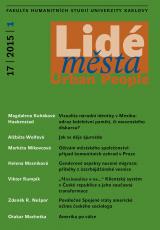Vizualita národní identity v Mexiku
Odraz kolektivní paměti, či mocenského diskursu?
DOI:
https://doi.org/10.14712/12128112.3409Klíčová slova:
Mexican nationalism, public art, muralism, identity negotiation, visual anthropologyAbstrakt
During the last two decades, some sections of the academic world have shown doubts concerning the validit y of the modernisation paradigm in nationalism studies in general, as well as of the applicabilit y of the “classic modernist” theories of nationalism for the analysis of nationhood outside of Western Europe. Among the suggested new approaches, which seem to be particularly fruitful in the case of Mexican nationalism, is the investigation of nationhood through its representations in visual language. Whereas both verbal and written forms of language were a key aspect in the shaping of the identit y of Western and Central European nations, visual language articulated in the public space (i.e. through murals), with its characteristic symbols and semiotic references, played a crucial role during the process of the homogenization of Mexican masses, especially at the beginning of the 20th century. This period was essential for the formation of the “vocabulary” and the content of Mexican national identity. Although the muralist movement was partially repressed for several decades (the 1950s–1980s), since the 1990s, public art has once again gained strength and has again become an important agent in the negotiation and the articulation of national identity all throughout Mexico. This paper analyses the role of visual communication in the process of the negotiation and of the shaping of specific versions of national identity, and that in the historical perspective and at present. I build on the long-term field research I carried out in Mexico during the past two years, on the study of nationalism theories and of national identity, and on the methodology of visual and interpretative anthropology.
Stahování
Publikováno
Jak citovat
Číslo
Sekce
Licence

Tato práce je licencována pod Mezinárodní licencí Creative Commons Attribution-NonCommercial-NoDerivatives 4.0.


